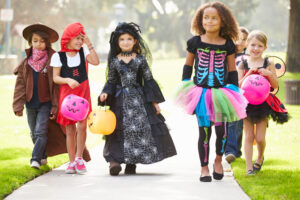October 06, 2022 | Black & Kletz Allergy
To the average parent, there is generally no association between Halloween and allergies. For some parents however, Halloween can be a “scary” time, but not because of ghosts and goblins. These “frightened” parents are parents that have a child who has food allergies. To the parent of a food-allergic child, the association between Halloween and food allergies is not only real, but can be downright scary and concerning.
Some food allergy statistics are in order at this point in order to shed light on the seriousness of food allergies. Approximately 8% of children in the U.S have food allergies. Food allergies are increasing and have increased by more than 50% in the last few decades. About one-third of children have food allergies to more than one food. Approximately 4 in 10 food-allergic children have had a severe reaction to a food. Peanut, followed by milk are the number one and two causes of food allergies in children. Tree nuts, shellfish, fish, eggs, wheat, and soy make up the next most common food allergies in children. If you are an observant parent, you can see that 6 of the top 8 food allergies are commonly found in many Halloween candies, assuming fish tacos and crab cakes are not common on your neighborhood block. To make matters worse, it is fairly common for miniaturized Halloween candies not to contain the nutritional information and allergen labeling, which is often found on the larger full-sized versions. This makes it even more difficult for a parent to screen for food allergens that may be in each treat. It should be noted that in order to be extra safe, a parent or child should live by the motto: “when in doubt, throw it out.”
Parents of a food-allergic child who are concerned about their child trick-or-treating on Halloween can go to the website of the Food Allergy Research and Education (FARE) organization and look at their program called the “Teal Pumpkin Project.” The Teal Pumpkin Project has been around since 2014 and its main objective is to increase awareness of the severity of food allergies as well as provide support to families who have food-allergic children. In the world of food allergies, the color teal signifies food allergy awareness. People with and without food-allergic children are encouraged to paint their pumpkins teal and display them by their front doors as a sign that their house is aware of food allergies and that they have alternative non-food containing “treats” for food-allergic children. Some non-food treats may include non-food treats may include stickers, toys, money, crayons, necklaces, bracelets, rings, glow sticks, hair accessories, finger puppets, bookmarks, vampire fangs, spider rings, balls, whistles, balls, etc. The houses with the teal pumpkins may also distribute traditional candies, but they will have separate bowls for food items vs. non-food items. FARE’s website provides a detailed “Teal Pumpkin Project Participation Map” so that participating houses can be easily assessed by the parents of food-allergic children.
In addition to the above Teal Pumpkin Project, other precautions should be adhered to with food-allergic individuals. Food-allergic children should be taught to graciously refuse homemade foods such as cupcakes and cookies that may not be safe for them. Young children should not trick-or-treat without parental supervision. Candies and treats without proper nutritional and allergen labeling should not be eaten in order to prevent a life-threatening allergic reaction. It is advised that one should trick-or-treat with an epinephrine self-injectable device such as an EpiPen, Auvi-Q, or Adenaclick. If an epinephrine self-injectable device is ever used, one should go immediately to the closest emergency room.
The board certified allergists at Black & Kletz Allergy support the efforts of the Teal Pumpkin Project and hope that our patients join in their efforts in order to try to make Halloween a safer holiday. Black & Kletz Allergy has always had a link to FARE. You will find it in the upper portion of our website under the blue “Resources” tab. Please click “LINKS” and then click “Food Allergy Research and Education.” The allergy specialists at Black & Kletz Allergy see both pediatric and adult patients and have over 5 decades of experience in the field of allergy, asthma, and immunology. Black & Kletz Allergy has 3 convenient locations with on-site parking located in Washington, DC, McLean, VA (Tysons Corner, VA), and Manassas, VA. The Washington, DC and McLean, VA offices are Metro accessible and we offer a free shuttle that runs between the McLean, VA office and the Spring Hill metro station on the silver line. To schedule an appointment, please call any of our offices or you may click Request an Appointment and we will respond within 24 hours by the next business day. We have been servicing the greater Washington, DC metropolitan area for over 50 years and we look forward to providing you with the highest state-of-the-art allergy care in a welcoming and relaxed environment.













